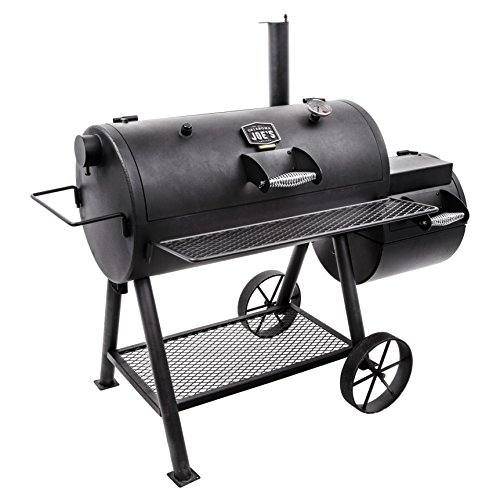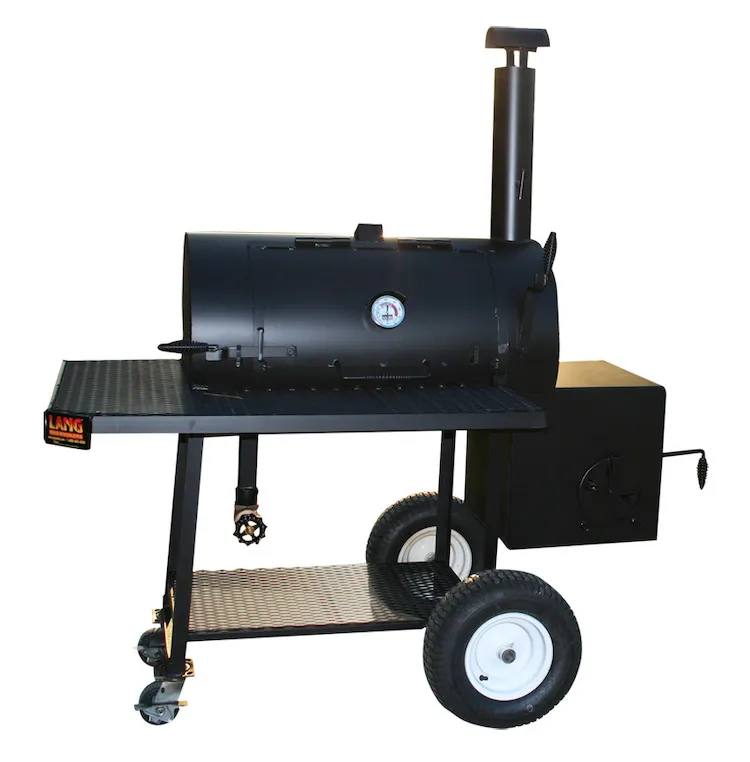If you’re in the market for an offset smoker, you’ve probably come across the term “Reverse Flow”.
Companies who produce this twist on the classic offset claim the superior design offers more even heat distribution, for better cooking results.
Read on to find out all about this design, and if the pros outweigh the cons.
How does a reverse flow smoker work?
In simple terms, a reverse flow smoker is a tweak to the standard offset smoker. The offset smoker mounts the firebox on the side of the smoker with a chimney often located on the opposite wall of the smoker.
With the firebox located outside of the cooking chamber, it’s easier to shield the food you’re smoking from the fire’s direct heat. Additionally, because of the placement of the chimney, the smoke is drawn up and across the food, maximizing its exposure.
The reverse flow smoker has the chimney mounted on the same side as the firebox.
The smoke coming from the firebox is directed by an additional baffle plate to the opposite side of the smoker and then drawn back across the cooking grill on its way to the chimney.
The benefit of using an additional baffle to reverse the smoke flow is that it is more evenly distributed both above and below the food.
The baffle plate also further shields the food from the direct heat of the fire and cools the smoke to create a more manageable internal temperature when cold smoking.
We have a full guide i you want to learn more about the art of operating an offset smoker.
Pros and Cons of reverse flow and offset smokers
While on the surface, it might seem that the greater consistency of the reverse flow smoker makes it superior to the offset smoker, the reality is that there are pros and cons to both.
If you’re considering buying a smoker and can’t choose between offset or reverse flow, here’s the breakdown:
Pros and Cons of reverse flow smoker
| Pros | Cons |
|---|---|
| The use of the baffle plate creates a more evenly balanced distribution of smoke | The baffled airflow makes it hard to get a very clean burn |
| The additional insulation of the baffle plate helps to create a more consistent internal temperature | Reverse flow smokers are less fuel-efficient than regular smokers |
| This increased consistency means the meat does not need to be flipped mid-cook | Because of the design and the addition of an extra baffle, a reverse flow smoker takes longer to come up to cooking temperature |
| The baffle also acts as a searing plate, cooking off the fat rendered from the food on the grill gate above and adding to the flavor | In some models, the baffle is welded in, making cleaning more difficult |
| The internal temperature is less prone to spiking when more fuel is added and returns to cooking temperature faster after the lid has been opened |
Pros and Cons of a standard offset smoker
| Pros | Cons |
|---|---|
| The lack of the additional baffle in a standard offset smoker means you get better airflow and the smoker comes up to cooking temperature faster | The internal temperature of a standard offset smoker is less consistent than a reverse flow smoker |
| The greater airflow also means you get a cleaner burn and therefore, cleaner smoke than a reverse flow smoker | The food needs to be flipped during the cooking process to ensure maximum smoke exposure |
| While the design does create hotspots, these can be used proactively to smoke different foods at different temperatures | The lack of a baffle does mean there will be a hot spot closest to the firebox. This makes it hard to smoke a lot of food without repeatedly rotating the food to ensure everything smokes at the same rate |
Are reverse flow smokers better?
As you can see from above, both reverse flow smokers and standard offset smokers have their benefits and drawbacks. However, in certain situations, one of these smokers’ designs might be more useful than the other.
If you’re a newcomer to smoking food or just want a more consistent smoker that doesn’t require as much babysitting, then a reverse flow smoker will give you a more uniform cooking temperature, and you won’t need to flip the meat.
The fact that the temperature is consistent across the cooking chamber also means you can smoke more food without needing to rotate the food out of any hotspots.
However, if you’re a more experienced smoker, you might want the cleaner burn and exploitable hot spots of the offset smoker to smoke food at different temperatures in one smoker.
Whether one style of smoker is ‘better’ than another is mostly based on your particular needs.
What is the best reverse flow smoker?
For our money, anyone looking to buy a reverse flow smoker can’t go wrong with either the excellently priced Oklahoma Joe Highland or the slightly more expensive Lang 36″ Original.
Oklahoma Joe Highland

Made from 100% heavy-gauge steel construction, the Highland overcomes one of the significant criticisms of offset smokers: poor body construction, which means they can’t hold a consistent temperature.
The Highland has a removable baffle, meaning you can set it up as reverse flow smoker or a traditional offset.
It also has two chimneys which can be opened or closed as needed to regulate airflow.
The Highland’s firebox also comes with attachable grill plates that allow you to grill and sear food directly over the flames’ heat.
Despite its solid construction and features, the Highland remains a very affordable piece of kit and a great first smoker if you’re just starting out.
Lang 36″ Original

Wrapping it up
Reverse flow smokers are great if you want a consistent and reliable smoker that really maximizes your food’s smoke exposure. They solve some of the hot spot issues of the traditional offset smoker and are a fantastic starting point for those dipping their toe into the world of smoked food.
Are you interested in buying a reverse flow smoker, or do you have one and have some top tips on how to get the best out of it? We’d love to hear about it in the comments section below.